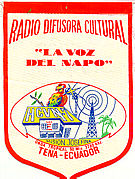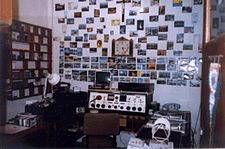|

|
 |
 |
| La
Voz del Napo, 3280 kHz |
DX
news |
 |
 Radio
María Ecuador is negotiating to buy the frequency 3280 kHz,
but not a direct purchase of La Voz del Napo, which is using
the frequency. Radio
María Ecuador is negotiating to buy the frequency 3280 kHz,
but not a direct purchase of La Voz del Napo, which is using
the frequency.
Radio María Ecuador broadcasts on FM from Quito, the province
of Guayas (I didn´t get the town), and from Santo Domingo
de los Colorados.
So far, La Voz del Napo still excists, giving IDs as usual,
while Radio María for the moment is buying programme time
on La Voz del Napo in Tena.
Björn Malm, Ecuador, hcdx partner SWB, 22 Dev 2001
Two reports a
week
By
Nick Grace C.
Elsa
and I arrived in Baños just before midnight, and much to my
suprise, she insisted on going to the local radio station.
You see, Elsa has absolutely no interest in radio - in fact,
it seemed that her only interest was to see the antenna and
get the Hell out of there. Ironically, I wasn't keen
on going to some flea-bag MW station during their graveyard
shift and waste expensive film and sleep time. My priority
was to tour SW stations. Let me change that...
My priority at that moment was to find anything solid and
fall asleep - on the steps of a church if I had to!
As it turns out, Elsa's friend in Baños is an announcer and
manager of La Voz del Santuario! And if that wasn't
enough the station used to be on shortwave over ten years
ago, but they quickly realized that SW means "no dinero."
As I stood in the studio, which occupied the entire top floor
of a townhouse, my jaw dropped at the sight of high-tech DAT
multi-tracks, US$5000 digital processors, automated DAT cart
machines, and a complete library of Network Music production
music. Talk about having friends in high places!
Yes, "La Compania," that is, the church heavily
funds this station.
We left the radio outlet to collapse in her friend's home.
The next morning, we got up early and went downtown to catch
yet another bus for Tena off in the distant Oriente.
Tena is roughly eight hours from Baños, and if anyone
wants to take a real roller coaster ride, the only road leading
into the city from the south is highly recommended. In order
to get there you must drop over 2000m through weaving and
muddy roads sometimes swerving precariously close to deep
jungle chasms. I clearly recall poking my head out of the
bus window to see the vehicles wheels six inches away from
a cliff as we were bolting down a mountain.
About two hours from Tena, the bus began to pick up school
children wanting to return home. These kids, natives of the
Amazon, must commute 20 to 40 kilometers just to study and
it hit me just how important radio really is in areas like
this where there are no telephones and where the jungle imposes
such a tremendous isolation.
Tena is a relaxed, slow-paced and extremely humid town with
caves and jungle trips to offer for tourists. But I had two
other locations on my mind: La Voz del Napo and Radio Oriental.
Elsa had only one: the caves.
La Voz del Napo, easily heard on 3280 kHz at 1000 GMT,
is situated toward the back of a small college campus run
by a Franciscan missionary called Misión Josefina. We walked
by a group of kids playing soccer and bumped right into the
stations director, Ramiro Cabrero. He kindly returned to the
stations pretty building with us for a short tour.
 La
Voz del Napo clearly appreciates the cards and letters it
receives. In fact, most of the walls are covered with pennants,
photos and postcards from all over the world. He estimates
that two reports come in each week for their morning program
and all are answered when possible with a card and colorful
pennant. La
Voz del Napo clearly appreciates the cards and letters it
receives. In fact, most of the walls are covered with pennants,
photos and postcards from all over the world. He estimates
that two reports come in each week for their morning program
and all are answered when possible with a card and colorful
pennant.
As I stood in the studio, looking more like a DXer's ugly
shack with cards and photos tacked to the walls, names jumped
out at me: Fred Kohlbrenner, Roland Archer, Steve Martin,
John Fisher...
"I remember your letter," Ramiro smiled as if he
had solved a great mystery.
"You sent a photo of yourself some years ago!"
My jaw nearly dropped and a sense of uneasiness set in since
when this fellow sent a verification card to me, it was accompanied
by a request for "a couple of hundred dollar bills..."
Hopefully, he wouldn't take the opportunity to hit me up for
a donation to his... Eh... Charity.
The station uses a CCA AM 2.5000 D/HF transmitter,
just down the hall from the on-air studio, and its dipole
antenna above the building pushes out about 2.5kW from 1000
to 1200 and 2300 to 0300 GMT every day.
Secretary Solia Verdesoto explained to me that the station
mainly serves the schools students, most of whom come from
isolated communities in the Amazon where there are no telephones.
They tell their families to listen to Napo for any messages
they may have, for instance, if they need money or help. My
mind quickly jumped to the admiration I have of those school
children traveling so far on the bus we arrived in.
Napo is a small station. Its been on the air for 28
years and employs only five people all teachers and administrators
of the college. They expect to move the antenna and transmitter
to another site, and in doing so, will also change the frequency.
Ramiro quickly left for a teachers' meeting but invited Elsa
and I to leave our bags inside the studio to tour the city,
which we did.
What a gorgeous sight! Under the Southern Cross constellation,
the parrot painted on the front of the building was lit up
like a star in the jungle. The music of crickets was so overwhelming
that we could even hear them from inside the stations studio.
Copyright
©1998 by Nick Grace C., All Rights Reserved
Permission to reproduce and/or quote information from this
site for non-profit, educational purposes is freely granted,
always provided that proper reference of the site and sources
be included. Reproduction and/or citation for profit and/or
non-educational purposes is expressly forbidden without prior
consent from the author.
|
|
|
|